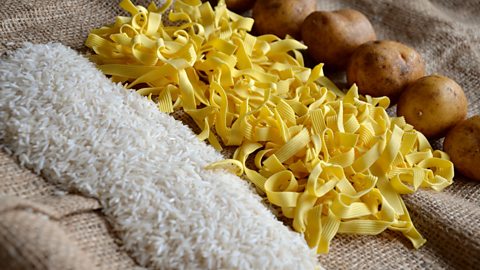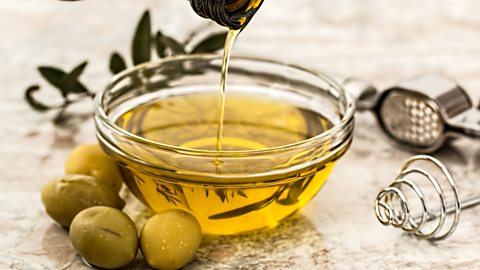The Eatwell Guide
The Eatwell GuideA chart that shows the five main food groups and illustrates examples of food in each group, showing the amount (proportion) from each group required in order to achieve a healthy, balanced diet. shows the five main food groups and illustrates examples of food in each group. It also shows the amount (proportion) of our diet that should be from each group in order to achieve a healthy, balanced diet.
The food groups are:

Image caption, Fruit and vegetables
Fruit and vegetables should make up about a third of our diet. We should aim for five portions a day as they are a good source of vitamins, minerals and fibre.

Image caption, Starchy carbohydrates
The main function of starchy carbohydrates is to provide energy but they're also a source of calcium, iron and B vitamins. They include potatoes, bread, rice and pasta.

Image caption, Protein
Found mainly in beans, pulses, fish, eggs and meat, protein is essential for the body's growth and repair. We should aim for at least 2 portions of fish per week.

Image caption, Dairy and dairy alternatives
Milk and dairy products, such as cheese and yoghurt, are great sources of protein and calcium.

Image caption, Fats and oils
Fat is a source of essential fatty acids, which our bodies can't make by themselves. It also helps absorb fat-soluble vitamins but we should be careful not to eat too much.
1 of 5
The guide also gives the following advice:
- Eat at least 5 portions of a variety of fruit and vegetables every day
- Base meals on potatoes, bread, rice, pasta or other starchy carbohydrates; choosing wholegrain versions where possible
- Have some dairy or dairy alternatives (such as soya drinks); choosing lower fat and lower sugar options
- Eat some pulses (like beans or lentils), fish, eggs, meat and other proteins (including 2 portions of fish every week, one of which should be oily)
- Choose unsaturated oils and spreads and eat in small amounts
- Drink 6-8 cups/glasses of fluid a day - ideally water but sugar-free drinks, tea or coffee count too.
If consuming foods and drinks high in fat, salt or sugar have these less often and in small amounts.
The Eatwell Guide was produced to help people make healthier food choices but is also an important guide for those responsible for drawing up menus and designing dishes in the hospitality industry.